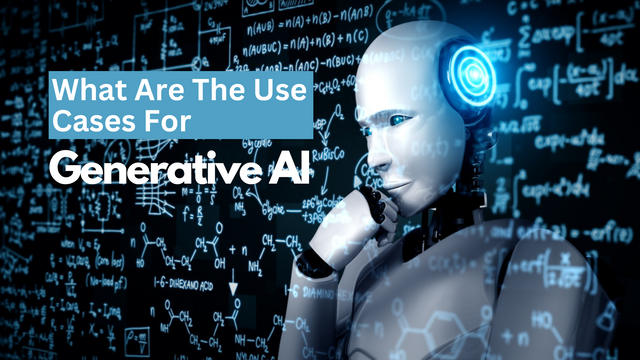What Are The Use Cases For Generative AI?

Generative AI, a transformative branch of artificial intelligence, has permeated various industries, reshaping how we create, interact, and innovate. This article explores the diverse use cases of generative AI, showcasing its ability to revolutionize everything from content creation to problem-solving.
1. Content Creation and Design
Generative AI has become a game-changer in content creation, producing visually stunning graphics, designs, and multimedia content. From generating unique images to designing logos and layouts, AI algorithms like DALL-E and Deep Dream showcase the potential of generative models to unleash creativity.
2. Natural Language Processing (NLP) and Text Generation
Advancements in generative models, such as OpenAI's GPT series, have revolutionized natural language processing. Use cases include automated content creation, chatbots for customer support, and even the generation of human-like text for various purposes, ranging from storytelling to academic writing.
SFWPExperts leads the way in creative innovation, seamlessly incorporating generative AI into our expertise. Our Wordpress developer experts team harnesses the power of generative models, redefining content creation and pushing the boundaries of possibilities. Explore the limitless potential of generative AI with SFWPExperts, where creativity meets cutting-edge technology.
3. Art and Creativity
Generative AI is leaving an indelible mark on the art world, with algorithms creating unique pieces of digital art, music compositions, and poetry. Artists and musicians leverage generative models to explore new realms of creative expression, challenging traditional notions of authorship.
4. Healthcare and Medical Imaging
Generative models play a pivotal role in medical imaging analysis and diagnostics. AI algorithms can generate synthetic medical images, aiding in research, training, and even predicting disease progression. This application contributes to improved accuracy in medical diagnoses and treatment planning.
5. Drug Discovery and Development
In the pharmaceutical industry, generative AI assists in drug discovery by predicting molecular structures and simulating chemical interactions. This accelerates the drug development process, potentially leading to the discovery of novel treatments for various medical conditions.
6. Financial Modeling and Forecasting
Generative AI contributes to financial modeling by analyzing historical data, predicting market trends, and identifying potential risks. Automated trading algorithms, powered by generative models, facilitate real-time decision-making in financial markets.
7. Video Game Development

Generative AI enhances the gaming industry by creating realistic environments, characters, and scenarios. Procedural content generation, driven by AI algorithms, enables game developers to generate vast, dynamic worlds with unique challenges, ensuring an immersive gaming experience.
8. Fashion Design and Style Recommendation
In the fashion industry, generative AI is employed for designing clothing, predicting fashion trends, and offering personalized style recommendations. This not only streamlines the design process but also enhances the retail experience for consumers.
9. Language Translation and Cross-Cultural Communication
Generative models aid in language translation, breaking down communication barriers and facilitating cross-cultural understanding. These models analyze contextual nuances to provide accurate and contextually relevant translations in real-time.
10. Robotics and Autonomous Systems

Generative AI contributes to the development of autonomous systems and robots by enabling them to perceive and respond to their environment. From autonomous vehicles to robotic assistants, generative models enhance decision-making and adaptability in dynamic situations.
11. Virtual Reality (VR) and Augmented Reality (AR)
Generative AI enhances the realism of virtual and augmented reality experiences. By generating lifelike environments, characters, and objects, it immerses users in a more authentic and interactive digital reality, revolutionizing entertainment, training, and simulations.
12. Cybersecurity and Threat Detection
Generative models are employed in cybersecurity for threat detection and anomaly identification. By analyzing patterns in network data, these models can detect suspicious activities and potential security threats, bolstering the defense against cyberattacks.
13. Environmental Conservation and Ecology
Generative AI aids in ecological research by simulating environmental scenarios, predicting climate patterns, and analyzing biodiversity. This contributes to informed decision-making for conservation efforts and sustainable environmental practices.
14. Education and E-Learning

In education, generative AI supports personalized learning experiences by creating adaptive educational content. Virtual tutors, generated quizzes, and interactive simulations enhance the effectiveness of e-learning platforms, catering to individual learning styles.
15. Human Resources and Recruitment
Generative AI is utilized in human resources for resume screening, candidate matching, and even conducting initial interviews. This streamlines the recruitment process, saving time and resources while ensuring a more efficient and unbiased hiring process.
Challenges and Ethical Considerations
- Bias in Data and Algorithmic Fairness
Generative models can perpetuate biases present in their training data, raising concerns about algorithmic fairness. Careful consideration and mitigation strategies are necessary to ensure unbiased outputs in various applications.
- Misuse and Ethical Concerns
As generative AI becomes more powerful, there is a growing concern about its potential misuse, such as the creation of deepfakes for malicious purposes. Establishing ethical guidelines and responsible use frameworks is crucial to mitigate risks.
- Explainability and Accountability
The inherent complexity of generative models poses challenges in understanding their decision-making processes. Striking a balance between model complexity and interpretability is essential for accountability, especially in applications where transparency is critical.
The Future of Generative AI
- Continuous Advancements in Model Complexity
The future holds continuous advancements in generative AI, with increasingly complex models capable of understanding and generating more intricate data. This evolution will unlock new possibilities in terms of realism, creativity, and problem-solving.
- Enhanced Cross-Domain Applications
Generative AI is expected to transcend traditional boundaries, finding applications across diverse domains. From scientific research to entertainment, the versatility of these models will continue to expand, fostering innovation and interdisciplinary collaboration.
- Ethical and Regulatory Frameworks
As generative AI becomes more prevalent, the development of robust ethical and regulatory frameworks becomes imperative. Establishing guidelines for responsible development and usage will be pivotal in harnessing the benefits of this technology while mitigating potential risks.
Conclusion
Generative AI stands as a testament to the transformative potential of artificial intelligence across myriad industries. From content creation to healthcare, its applications continue to redefine the boundaries of innovation. As we navigate the ethical considerations and challenges, the future promises not only more sophisticated algorithms but also a collective responsibility to ensure the ethical and responsible deployment of these powerful tools.
Read More Articles:
Unveiling the Transformative Power: Exploring the Benefits of Generative AI
Next-Gen WordPress: Embracing The Age Of Artificial Intelligence
What Are Generative AI Models?
What Is Guerrilla Marketing? Top Effective Examples And Tactics